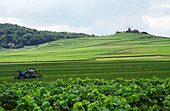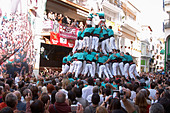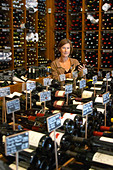We have updated our events calendar with several new events : competitions, shows and other. Thank you to FIJEV (Federation International des Journalistes en Vin) who had put the list together:
- 25-27/01 Montpellier (F) : Millésime Bio www.millesime-bio.com
- 28-30/01 Mumbai (IND) : India International Wine Fair, http://www.taste-expo.com/
- 30-31/01 Chassagne (F) : Saint Vincent Tournante, http://www.st-vincent-tournante.fr/
- 4-7/02 Berlin (D) : Berliner Weintrophy, http://www.berliner-wein-trophy.de
- 1-3/02 Angers (F) : Salon des vins de Loire, http://www.salondesvinsdeloire.com/
- 22-24/02 Montpellier (F) : Vinisud, http://www.vinisud.com/
- 24-24/02 Sonoma (USA) : Grand Harvest Awards, http://www.vwm-online.com/wine_competitions/grand_harvest/index.asp
- 26-02-2/03 Paris (F) : Vinalies Paris, http://www.vinalies-internationales.com/en/
- 3-5/03 Thessalonique (GR) : Concours Int . du Vin de Thessalonique, http://www.wineroads.gr/eng/index.php
- 5-7/03 Aiseau-Presles (B) : Salon Saint Vincent, http://www.salonduvinfloreffe.be/
- 10-13/03 Saint Lager (F) : Chardonnay du Monde, http://www.chardonnay-du-monde.com/
- 12-16/03 Madrid (E) : Bacchus
- 21-23/03 Düsseldorf (D) : Prowein, http://www.prowein.com/
- 22-26/03 Barcelona (E) : Alimentaria Barcelona, http://www.alimentaria-bcn.com/
- 22-27/03 Beaune (F) : Grands Jours de Bourgogne, http://www.grands-jours-bourgogne.com/
- 25-28/03 Montréal (CDN) : Salon des Vins & Spiritueux de Montréal, http://www.salondesvins.com/
- 8-12/04 Verona (I) : Vinitaly, http://www.vinitaly.com
- 16-18/04 Olne (B) : Salon des vins bio & naturels, http://www.salondesvignerons.be/
- 23-25/04 Palermo (I) : Concours Mondial de Bruxelles, http://www.concoursmondial.com/
- 29/04-06/05 Adelaide (AUS) : Tasting Australia, http://www.tasting-australia.com.au/
- 13-16/05 Aigues-Mortes (F) : Oenovideo, http://www.oenovideo.oeno.tm.fr/
- 18-20/05 London (GB) : London Wine Fair, http://2010.londonwinefair.com/
- 25-27/05 Hong Kong (CN) : Vinexpo Hong Kong, http://www.vinexpo.com/en/asia-pacific-2010/
- 27-28/05 Ampuis (F) : Syrah du Monde, http://www.syrah-du-monde.com/
- 28-31/05 Ljubljana (SLO) : Vino Ljubljana, http://www.ljubljanafair.com
- 1-6/06 Québec (CDN) : Sélections Mondiales des Vins Canada, http://www.smvcanada.ca/
- 17-20/06 Visegrád (H) : Vinagora, http://www.aborfesztival.hu/
- 1-2 /07 Frontignan (F) : Muscats du Monde, http://www.muscats-du-monde.com/
- 16-21/08 Stellenbosch (ZA) : Michelangelo Wine Awards, http://www.michelangeloawards.com/
- 20-22/08 Sierre (CH) : Mondial du Pinot Noir, http://www.mondial-du-pinot-noir.com/
- 26-08-05/09 Neustadt (D) : Mundus Vini, http://www.mundusvini.de
- 12-14/11 Lugano (CH) : Mondial du Merlot, http://www.mondialdumerlot.com
Read more...
 A big problem in many vineyards today is ’maladie de bois’ (wood disease?). It is a fungal disease that attacks the vine and finally kills it (there are several different types, e.g. esca and eutypiose). Previously, it has been effectively treated with a mixture containing arsenic, but since it turned out to be harmful not only to the vine it is now forbidden. Today the wine growers just have to wait until the vine dies and then pull it up (or pull it up earlier of course). But there is a problem – you have to make sure you get as much as possible of the roots out of the ground since otherwise the virus will remain in the sick root. And that is not easy to do. In Auvergne they have been doing tests with a mini-excavator with a contraption that can pull up the vine and almost all of the roots, and it has proven to do a pretty good job. Read more on the tests here: www.sauvat-vins.com (Photo: Sauvat-Vins)
A big problem in many vineyards today is ’maladie de bois’ (wood disease?). It is a fungal disease that attacks the vine and finally kills it (there are several different types, e.g. esca and eutypiose). Previously, it has been effectively treated with a mixture containing arsenic, but since it turned out to be harmful not only to the vine it is now forbidden. Today the wine growers just have to wait until the vine dies and then pull it up (or pull it up earlier of course). But there is a problem – you have to make sure you get as much as possible of the roots out of the ground since otherwise the virus will remain in the sick root. And that is not easy to do. In Auvergne they have been doing tests with a mini-excavator with a contraption that can pull up the vine and almost all of the roots, and it has proven to do a pretty good job. Read more on the tests here: www.sauvat-vins.com (Photo: Sauvat-Vins)




















